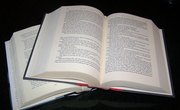Writing a humanities paper for a college class can be a challenging task. Students often assume that they can gather a couple of Internet sources and simply summarize or paraphrase the work of other writers. This is not the case. Professors in the humanities look for papers that show multiple sources, originality and analysis and provide a clear thesis and conclusion.
Choose your topic. Unless your professor has assigned a topic or has given you a list to choose from, go to the index of your textbook and search for topics of interest to you. Read all the material in your textbook regarding that topic to ensure that you will be interested enough in the topic to see the paper through to the end.
Gather source material. Start your research by conducting an Internet search. Use only quality Internet sources; avoid using web sites with .com or .net suffixes, which generally have no credibility in the academic community. Avoid the popular Wiki sites because of credibility issues. Instead, use these sources as guides to finding other source material. Check out the bibliographies of these sites to find scholarly works in the field.
Read your source material. You need not read every word of each of your sources, but you should have a general idea of what material is contained in each source. Look for the main idea or thesis of the author, supporting material and conclusions. Write a summary of each source in your notebook for quick perusal later.
Determine your thesis. Your research should yield a pattern that indicates a possible thesis statement. For example, if you are writing a paper on the philosophy of Friedrich Nietzsche, look for the primary conclusions that your sources have drawn about Nietzsche. If nine of every 10 authors you read conclude that Nietzsche was a "prophet of modernity," then this is a possible source for a thesis statement. Your paper could explain why Nietzsche was prophetic in his assessment of the modern condition.
Write your paper. Begin with an introductory paragraph that summarizes the rest of your work. Avoid using personal pronouns such as "I" or "we," in order to make your work seem more scholarly in its tone. The introduction should contain your thesis stated clearly and precisely. The remainder of your paper should provide supporting material to prove the thesis.
Proofread your paper. This step is essential before turning in your work. Run your paper through online plagiarism detection software. Make sure that your conclusion logically follows from your thesis and that your supporting material does just that. Read your paper carefully to check for spelling and grammatical errors.
Revise your paper. The best papers are those that have been written and rewritten. Do not assume that it will be perfect on the first draft. Taking the time to proofread and revise your paper at least once can make all the difference between obtaining an average grade and an above-average grade.
Tip
A good rule of thumb on source material is to use approximately one source per page. For example, if your paper is to be eight to 10 pages long, you should have a minimum of eight to 10 sources.
Tip
The best place to look for research material is through online academic databases offered through your college's library. A username and password are generally required to access this material. Once you have obtained these, you can conduct advanced searches using multiple keywords. Look for peer-reviewed journals rather than popular magazines and periodicals. Recent books in the field published within the last 10 years are generally acceptable source material as well.
Tip
It may be a good idea to have someone else read your paper before you turn it in. Find someone who can provide an objective reading. Do not ask family members to do this for you. They may not be as critical of your work as a classmate or co-worker. The more critical their assessment, the better your revision will be.
Warning
Do not simply summarize the work of other scholars; draw on it when necessary by alluding to it or quoting it directly. Do not string together paragraph after paragraph of quoted material, however. This can be viewed as plagiarism.
Related Articles
References
Tips
- A good rule of thumb on source material is to use approximately one source per page. For example, if your paper is to be eight to 10 pages long, you should have a minimum of eight to 10 sources.
- The best place to look for research material is through online academic databases offered through your college's library. A username and password are generally required to access this material. Once you have obtained these, you can conduct advanced searches using multiple keywords. Look for peer-reviewed journals rather than popular magazines and periodicals. Recent books in the field published within the last 10 years are generally acceptable source material as well.
- It may be a good idea to have someone else read your paper before you turn it in. Find someone who can provide an objective reading. Do not ask family members to do this for you. They may not be as critical of your work as a classmate or co-worker. The more critical their assessment, the better your revision will be.
Warnings
- Do not simply summarize the work of other scholars; draw on it when necessary by alluding to it or quoting it directly. Do not string together paragraph after paragraph of quoted material, however. This can be viewed as plagiarism.
Writer Bio
Jared Lewis is a professor of history, philosophy and the humanities. He has taught various courses in these fields since 2001. A former licensed financial adviser, he now works as a writer and has published numerous articles on education and business. He holds a bachelor's degree in history, a master's degree in theology and has completed doctoral work in American history.











